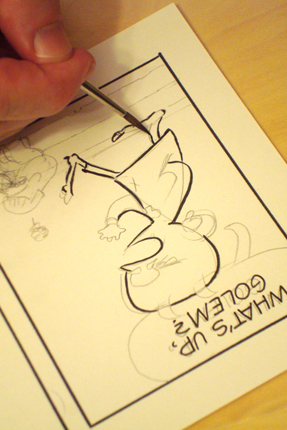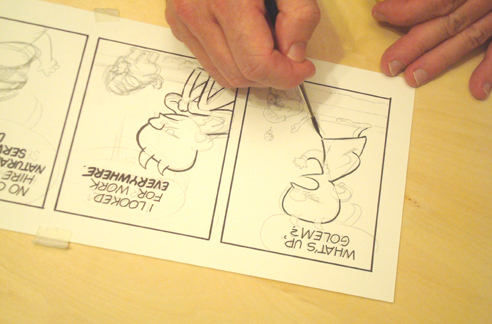Look Ma, No Command Z!
on June 15, 2011
Thought I’d take a few pics while I work tonight and share them with you. I use a Winsor & Newton Series 7 #2 round brush on bristol board. I letter with Pigma pens and border with a Sakura marking pen. No Command Z here! If I make a mistake I’ve got a small jar of Luma bleed proof white for corrections. I’m experimenting with working in a smaller format to see if it might speed up the process a bit. I was working at 16.25″ x 4.75″, and now I’m working at 14.5″ x 4.25″. The new size is about 85% smaller. So far, so good.




Discussion (24) ¬
Cool, man LOVE to see people’s process. I also prefer a smaller brush to ink with, a lot of inkers will tell you to use the big one, but I just can’t get the control I need. Also, I think we’re only two people left who pencil with regular lead – I don’t like that waxy texture blue pencils have.
Thanks, Jeff. I usually use a #2 brush, a good all around thickness, but I may have to switch to a size smaller since I’ve downsized the strip size by 88%. I’ll give it a go for awhile and see how it works out.
Looks good, thanks for sharing. Do not have the patience, skill, and guts to try that anytime soon myself..
Thanks for dropping by, Barry. I always hated working with a brush! I preferred using those Japanese marker brushes, because they were more like a pen. I forced myself to keep pushing through and finally made some kind of peace with this strange object made from the hind end of a weasel.
Brush and ink on paper?! That’s so, so. . . barbaric!
And can you imagine paint on canvas? Yuck! The Mona Lisa is so…so…primeval!
I never could get the hang of Japanese brush pens. I never felt in control of what the tip was doing. I actually like inking with a brush, as I feel the most in control then, but I never did master doing tiny little details – I still do that kind of stuff with a Micron (or the Japanese equivalent).
Now, anybody still cutting zipatone in this day and age… THAT would be BARBARIC… 🙂
I love to see that some cartoonists still do it the old-fashioned way. I use similar methods.
Cool, George. I’d love to know how you put your strips together.
George had a behind the scenes look at his process in his blog at one point. Maybe about a year ago?
Thanks for letting me know. I’ll have to look that up.
Nice tutorial,
I have been thinking about getting some brushes my self.
I have been using only artline pens for my comic.
Hello Hjortur! Thanks for coming by my site and commenting. I’m glad you liked the article on my brush work. I love the brush because it gives you so many line options to work with. Brushes can be a bit expensive, but they’ll last a long time if you take good care of them. Your pen work is really nice, though. I like your layouts and color, too.
Wow you must have a very steady hand. Love that you use a brush.
I used to hate brushes when I was just starting. Could never control ’em and they were always slopping away from the line. I switched to those marker brushes and learned how to make the line go where I wanted it to, and eventually went back to a real brush. I just like how you can make a line breathe with a brush, pens are good but they seem to be a bit sterile to me. Maybe you could try to experiment some with a brush. I think it would suit your work very well…
Amazing work Mark. I love working with brushes, unfortunately it’s much more time consuming than working digitally, so the only time I get to work with brush and ink is when I draw something for myself aka for fun 🙂
I understand what you’re saying, although I don’t see how working digitally is any quicker. You still have to draw each line. The only advantage I can see is the ability to move things around and art revisions are quicker. I’m glad to know you work traditionally, I think all artists need to get some real pencil and ink on paper every now and then.
Wow, think I just set the world record for late response…anyway, when I work for other people it is much faster and less frustrating to work digitally. For example, while I was working on Imagine Industries, we had so many dialogue changes that if I had to write them by hand I think I would have chopped my hand off. And sometime had a really big changes, for example redraw the whole panel or two, and I had to do it really fast. Oh and the most important reason, if I was to draw II traditionally, I would draw it on 16.5 x 11.7 size paper, and I don’t have scanner in that size at home, which would mean that I have to take it somewhere and get it scanned and that really takes too much time. Sure, I could draw few panels on one paper and the other panels on another, but I just don’t want to do that. I wanted to ask you (if you ever see this comment :)) how do you take care of your brushes? I wash mine with soap and warm water, and let them dry on their own. And I agree that every artist needs to work with pen and paper every now and then, and I also think that artist needs to work traditionally before going digitally. Digital art without experience can lead a person in a very bad direction.
oh almost forgot, sorry for the late response 🙂
Always better late than never! Thanks for the great response, Aleksandar!
Only someone who has a background in traditional media could write something like this! Your advice is sound for anyone who wants to work digitally — get some “hands-on” experience, too! Thanks for sharing your great insight, Aleksandar!
I’m working my way through your archives when I came across this. Thank you so much! It’s so helpful to see an artist’s “Process”.
I love process articles too, Michael. I put this together with that same thought in mind. I can’t get enough of the “behind the scenes” stuff, it’s probably time to post some more!